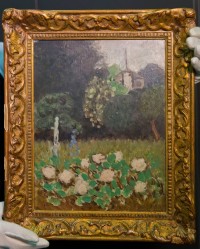 A Matisse painting stolen from the Moderna Museet in Stockholm, Sweden, in 1987 was discovered by an art dealer in Essex just before Christmas 2012. The painting was brought to Charles Roberts by an 85-year-old Polish collector who wanted to sell it. As a proper responsible dealer, Roberts checked the Art Loss Register and found that it had been stolen and was missing for a quarter century.
A Matisse painting stolen from the Moderna Museet in Stockholm, Sweden, in 1987 was discovered by an art dealer in Essex just before Christmas 2012. The painting was brought to Charles Roberts by an 85-year-old Polish collector who wanted to sell it. As a proper responsible dealer, Roberts checked the Art Loss Register and found that it had been stolen and was missing for a quarter century.
He hasn’t been dealing art professionally very long and this was one of the first paintings he had the opportunity to sell. It would have been a major score for him to handle a million-dollar Matisse while just starting out, so it was a stone cold bummer to discover that it belonged to someone else.
“I didn’t anticipate hearing that it had been stolen. It came as quite a shock to find that out,” Roberts told AFP. “It would have been good all round, but unfortunately it wasn’t to be. As soon as I was informed of its status there was no question about doing anything but returning it.”
Good man. When experts confirmed the identity of the painting, the Art Loss Register’s executive director Christopher Marinello in London claimed the piece. It was a swift resolution. Recovery of stolen artifacts require not just authentication but extensive negotiation. Arranging the return can often take years of legal wrangling. In this case it took three weeks, and there was a Christmas holiday in the middle of that. The painting was put it in a safe at the ALR offices until it could be returned to its rightful owner.
The Stockholm modern art museum had owned the Le Jardin since it was gifted to them by Mrs, Nora Lundgren November 15th, 1977. Less than 10 years later, on May 11th, 1987, a burglar smashed through the front door using a sledgehammer and stole the 1920 work by the French artist. The museum’s alarm did go off, but by the time the security guards got there 10 minutes later, the thief and the painting were gone.
Several attempts were made at the time to extort the museum. The thief/thieves offered to return the painting for an exorbitant ransom, but Museum Director Lars Nittive refused to negotiate with terrorists, to coin a phrase. Nittive stated to the press that he thought the painting was too recognizable to be easily sold, that he wouldn’t cave to the burglars’ demands. He was right; the painting was too visible for sale on the open market. Instead it disappeared into the black one and the trail went cold for two decades.
Despite the two-decade cost, Marinello thinks Nittive did the right thing.
“I commend the Museum for not giving in to ransom demands a quarter century ago. Stolen artwork has no real value in the legitimate marketplace and will eventually resurface…it’s just a matter of waiting it out.”
During that long waiting period, somehow Le Jardin got to Poland where it was purchased by the collector who hoped to sell it through Charles Roberts. Marinello does not believe the collector had anything to do with the theft (I still think he’s ultrashady for having bought it without even checking the ALR database) as the piece likely went through numerous hands over the years. It’s unlikely we’ll ever know what happened to the painting during those decades. ALR officials notified the police but they didn’t appear interested in pursuing an old international burglary case.
The painting was returned to the Stockholm museum on January 22nd, 2013. The museum documented its return on their Instagram page. Scroll down to the first January 23rd picture, click it and then click through to January 26th to see them all in a little chronological slideshow. The pictures are small and have those stupid Instagram effects, but they’re not too obnoxious. It’s neat to see the painting go from inspection to crate to display.
Matisse was living in Nice in 1920. His work during this post-war period mainly focused on female nudes or odalisques in Orientalist garb. These are interiors, albeit bright, warm, colorful interiors that reflect the palette of southern France which so inspired artist before him. He also took advantage of his surroundings — “simpler venues which won’t stifle the spirit,” as he put it — to paint landscapes with the “silver clarity of light” he found in Nice. Le Jardin is a fine example of his relaxed, warm work from the early Nice period.
He may not have “scored” a big sale, but he certainly has scored a reputation as a responsible dealer, and doubtless that will count for something.
The original thieves seem to have belonged to the class of those who are opportunistic – haven’t thought out what happens next but figure that the painting is valuable and therefore must be cashable. But because each piece is unique and instantantly recognisable, art in fact makes a poor target.
Then there are those cases described as “professional” – like this, which I came across while googling Charles Roberts:
http://arthostage.blogspot.com.au/2013/01/stolen-art-watch-dealer-hands-back.html
Looks like quite an interesting blog. Anyway, the point is, did these other thieves (the ones in the blog) have a shopping list as the police say? As they targeted Chinese stuff, I guess it’s possible – the market must be so much larger, and the recognisability factor much lower.